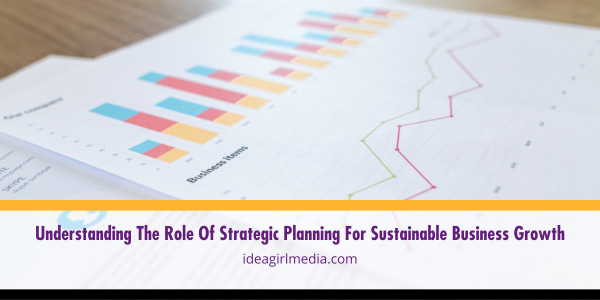What is strategic planning?
What is strategic planning? Why is it important? All entrepreneurs and business leaders want to achieve sustainable business growth. This article details ten essential steps involving multiple department functions to succeed...
10 Steps To Successful Strategic Planning For Any Business Looking To Grow
Successful business operation depends on its ability to formulate and implement a sound strategy. Strategic planning is crucial to long-term viability -- It involves setting objectives to help meet goals while creating processes and activities to reach these targets. Charting the future also enables organizations to remain competitive by offering sustainable growth and profitability strategies.
Strategic planning also allows organizations to anticipate potential risks or opportunities and make adjustments accordingly, leading to improved:
- Efficiency
- Productivity
- Cost savings over time
Without proper planning of this type in place, businesses may fail to realize their full potential, leaving them susceptible to rising costs and competition in their market. It is an absolutely essential effort for any organization hoping to achieve lasting success.
Here are ten proven steps to understanding the role of strategic planning for sustainable business growth.
1. The Importance Of Strategic Planning
Doing business has become increasingly complex over time, presenting companies with new challenges and opportunities they cannot anticipate. Long-term planning is essential in this environment to enable organizations to make informed decisions that keep them competitive.
Through strategic planning, businesses can identify future trends while planning accordingly for possible risks or pitfalls. By creating plans which take both short-term and long-term objectives into consideration, companies are better positioned for long-term success both now and into the future.
2. Establishing Effective Strategy
In order to craft an effective strategy, organizations must first identify their core values and strengths. This is particularly crucial when operating in adaptive markets where firms must quickly respond to market fluctuations.
Companies should evaluate every aspect of their operations from production and marketing through customer service to technological development -- not forgetting any opportunities for growth that exist both competitively as well as economically.
3. Establishing Objectives And Goals
Once a company has assessed its strengths, weaknesses and potential opportunities, it should begin setting objectives and goals. This could involve:
- Entering new markets
- Improving customer service standards
- Creating innovative products or services
- Increasing productivity
The list could go on!
Personalized to your organization's specific needs as well as external factors like:
- Competition
- Technological advances
- Economic climate
These objectives should include short-term and long-term targets to reach in a matter of months or years, respectively.
4. Deliberate Risks And Opportunities
Organizations should remain cognizant of both risks and opportunities in their industry.
Companies should identify any obstacles to meeting goals such as inadequate resources or regulatory noncompliance, then utilize strategic planning techniques to seek new business opportunities. Whether that means taking advantage of new technologies or capitalizing on emerging market trends in early phases.
Doing this will allow businesses to stay ahead of competitors while positioning themselves for long-term success.
5. Establishing Process And Activities
Once an organization has defined their goals, they should develop the processes and activities to reach them. This may involve setting milestones along the way that serve as benchmarks of progress towards meeting them, as well as accountability measures like performance reviews or progress reports to monitor and maintain visibility into operations.
Establishing these processes can ensure organizations stay on course towards meeting their ultimate goal.
6. Tracking Progress And Altering Strategies

Even after creating an in-depth strategy, organizations still must keep an eye on progress and adjust as necessary. This is especially important in challenging or unpredictable markets where companies must quickly adapt as conditions fluctuate.
To stay ahead of the game, executives and managers should regularly analyze performance data to identify areas for improvement or adjustments, as well as use customer feedback and market research to ensure their strategies remain relevant over time.
7. Outsourcing
As businesses grow, they may discover it beneficial to outsource certain daily tasks to outside service providers to streamline operations and free up internal resources for more pressing matters. Popular outsourced services are:
- Accounting
- Payroll processing
- Customer service support
- Live receptionist service
All enable teams to focus their energy on larger initiatives while assuring basic needs are efficiently covered.
8. Benefits Of Strategic Planning For Sustainable Growth
Strategic planning is an indispensable process for expanding, and maintaining a thriving business:
- Assessing current performance
- Identifying opportunities
- Setting objectives
Those steps allow organizations to establish a path toward long-term success.
This process also enables companies to focus on core competencies while staying ahead of market trends and emerging technologies. In turn, they remain agile and competitive within today's rapidly changing environment.
9. The Function Of Technology In Strategic Planning
The impact of technology on the processes of strategic planning might be surprising to some.
- Cloud-based collaboration tools
- Increased data analysis and
- Forecasting skills
All are examples of how new technologies are assisting businesses in their planning efforts. Additionally, artificial intelligence enables organizations to recognize trends or patterns which would otherwise go undetected.
By taking advantage of technological advancements, firms can maximize impact with their strategies while remaining competitive in today's business marketplace.
10. Maximizing Effectiveness
To make strategic planning effective, brands must focus on three areas:
- Clearly establish objectives that are in alignment with the overall mission.
- Create processes to monitor whether goals are being reached.
- Utilize cutting-edge technologies for tracking performance data and making adjustments as needed.
Using this approach can pave a path towards sustainable growth while remaining ahead of the competition in today's business environment.
Summing It Up: Prioritizing The Value Of Strategic Planning
Strategic planning is an indispensable asset for modern organizations seeking to remain competitive and achieve long-term success. Through taking a proactive approach to strategic planning, companies can:
- Identify areas of opportunity
- Assess performance data
- Modify strategies as necessary
- Leverage new technologies effectively
And stay agile within fast-changing markets -- ultimately optimizing efforts for maximum return, sustainable growth and long-term success.
0 Replies

Like what you see? We've been told our blog posts are like potato chips: You can't read just one...
Subscribe to receive them fresh in your Inbox, and you can grab our best insights about social media marketing before everyone else sees it!

Relevant Resources
view allThe True Cost Of Letting Peak Sales Periods Pass You By

Three Surprising Signs You’re Still Silencing Your Female Employees

How Ongoing Training In The Workplace Can Drive Long-Term Business Growth






































Leave a Reply